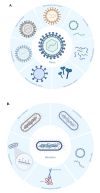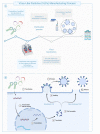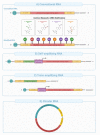Vaccine Technologies and Platforms for Infectious Diseases: Current Progress, Challenges, and Opportunities
- PMID: 34960236
- PMCID: PMC8708925
- DOI: 10.3390/vaccines9121490
Vaccine Technologies and Platforms for Infectious Diseases: Current Progress, Challenges, and Opportunities
Abstract
Vaccination is a key component of public health policy with demonstrated cost-effective benefits in protecting both human and animal populations. Vaccines can be manufactured under multiple forms including, inactivated (killed), toxoid, live attenuated, Virus-like Particles, synthetic peptide, polysaccharide, polysaccharide conjugate (glycoconjugate), viral vectored (vector-based), nucleic acids (DNA and mRNA) and bacterial vector/synthetic antigen presenting cells. Several processes are used in the manufacturing of vaccines and recent developments in medical/biomedical engineering, biology, immunology, and vaccinology have led to the emergence of innovative nucleic acid vaccines, a novel category added to conventional and subunit vaccines. In this review, we have summarized recent advances in vaccine technologies and platforms focusing on their mechanisms of action, advantages, and possible drawbacks.
Keywords: DNA vaccine; Virus-like Particles; inactivated vaccine; live attenuated vaccine; mRNA vaccine; next generation vaccines; polysaccharide vaccine; toxoid vaccine; vaccine; vaccine platforms; vaccine types; viral vectored vaccine.
Conflict of interest statement
The authors declare no conflict of interest.
Figures








References
-
- Haas E.J., Angulo F.J., McLaughlin J.M., Anis E., Singer S.R., Khan F., Brooks N., Smaja M., Mircus G., Pan K., et al. Impact and effectiveness of mRNA BNT162b2 vaccine against SARS-CoV-2 infections and COVID-19 cases, hospitalisations, and deaths following a nationwide vaccination campaign in Israel: An observational study using national surveillance data. Lancet. 2021;397:1819–1829. doi: 10.1016/S0140-6736(21)00947-8. - DOI - PMC - PubMed
-
- W.H.O Vaccines and Immunization. [(accessed on 10 December 2021)]. Available online: https://www.who.int/health-topics/vaccines-and-immunization#tab=tab_1.
Publication types
LinkOut - more resources
Full Text Sources
Other Literature Sources

